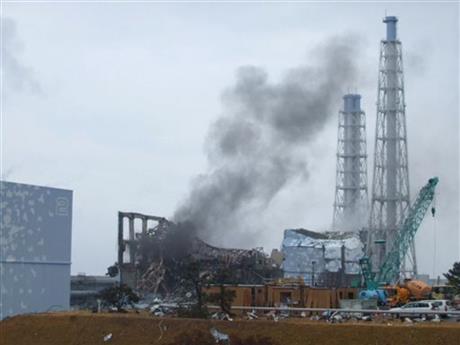
By RAY HENRY
FILE – In this March 21, 2011 file photo provided by Tokyo Electric Power Co. (TEPCO), smoke rises from the Unit 3 reactor of the tsunami-damaged Fukushima Dai-ichi nuclear plant in Okuma town, Fukushima prefecture, northeastern Japan. The U.S. government has intensified research on more durable fuel in the aftermath on the accident in Japan. (AP Photo/Tokyo Electric Power Co., File) EDITORIAL — USE ONLY
ATLANTA (AP) — The explosions that damaged a crippled Japanese nuclear plant during a disaster that forced mass evacuations in 2011 show what can happen when nuclear fuel overheats.
In response to the Fukushima Dai-ichi accident, the U.S. government dramatically increased funding to develop tougher protective skins for nuclear fuel, hoping to spur innovation in designs that hadn’t changed much in years. While the U.S. Department of Energy was spending $2 million before the accident on future fuel designs, the funding reached as much as $30 million afterward.
Now scientists at multiple institutes are in the middle of developing designs that could start finding their way into test reactors as soon as this summer, followed by larger tests later on.
The goal is to create nuclear fuel that that is more resistant to damage and melting in extreme situations and less prone to a chemical reaction that makes its metal wrapping brittle and produces explosive hydrogen gas. If researchers succeed, their work could give plant workers more time to keep an accident from spiraling into a meltdown that releases harmful radiation. The work is no cure-all to prevent accidents, but it’s a way of reducing risk.
“It’s basically buying time for the reactor,” said Andrew Griffith, the Energy Department’s director for fuel cycle research and development. “It’s basically an insurance policy.”
Scientists in the government- and industry-funded efforts are experimenting with multiple solutions before narrowing their focus on the most-promising technologies.
Nuclear fuel has remained similar for decades. Uranium dioxide is compressed into a pellet about the size of a fingertip. Those pellets are stacked into fuel rods up to 15 feet long and placed in a tube, called cladding, made from zirconium alloy. That metal cladding resists corrosion in a reactor, holds up against heat and serves as a barrier that keeps radioactive elements in place without cutting too much into the energy produced by a nuclear plant.
Nuclear fuel is supposed to withstand accident conditions, but the disaster at the Fukushima Dai-ichi plant shows how it can fail when pushed to extremes.
After an earthquake, tsunami waves crashed over the plant’s seawall and disabled the electrical gear needed to run reactor cooling systems. When the cooling systems and backups stopped working, the reactors overheated. As water levels dropped, the metal cladding around the fuel reacted with steam and oxidized, producing hydrogen gas. Scientists blame that escaping hydrogen gas for causing multiple explosions that damaged the facility.
The same reaction also produces heat, further contributing to the extreme temperatures that allowed fuel to melt and radioactive byproducts to escape. Some oxidation occurs during a reactor’s normal operation, but nowhere near the levels that occur in an extreme accident.
Scientists are considering a range of improvements.
Some are proposing fundamental departures. The Electric Power Research Institute is experimenting with cladding made of molybdenum, which maintains its strength in higher temperatures than the current zirconium alloys. A stronger metal would do a better job keeping nuclear fuel from melting and slumping in a reactor during extreme accidents.
Engineers at the University of Tennessee are trying to coat cladding with ceramics that can withstand higher temperatures than the existing cladding, while Westinghouse Electric Co. hopes to use silicon carbide as the base for its claddings in future fuel designs.
Quicker improvements may come from changing existing fuel designs. A nuclear engineer at the University of Illinois, Brent Heuser, received U.S. funding to develop coatings that could be applied to existing cladding to prevent the chemical reaction that produces hydrogen, heat and weakens the cladding. His team is also interested in “self-healing” fuel, which has added materials that migrate to the surface of a fuel rod during an accident and form a protective coating.
Any change must make financial sense. Adding safety improvements costs more money. That’s not attractive to cost-conscious utilities since the existing cladding already meets federal safety rules.
To get around the economic obstacles, some researchers hope to offset the extra cost of the protection measures by combining them with fuel that produces more energy before it must be replaced. Others like Heuser say regulators would need to force utilities to use the safer products.
“It’s often where businesses and regulatory bodies butt heads,” Heuser said.



